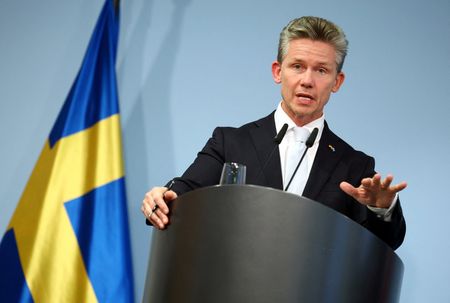By Gleb Stolyarov
MOSCOW (Reuters) -Russia’s government is discussing different ways to prop up Russian Railways, the country’s biggest commercial employer, which has built up a 4 trillion rouble ($50.8 billion) debt pile, two people with knowledge of the matter told Reuters.
State-owned Russian Railways, which employs about 700,000 people, has suffered a fall in revenues amid a sharp slowdown in Russia’s war economy while debt costs have soared, driven by the highest interest rates in two decades.
According to two people who spoke on condition of anonymity due to the sensitivity of the matter, Moscow has been discussing ways of helping the railways deal with its debt, mostly owed to state banks.
Those include raising prices for cargo, raising subsidies, cutting taxes or even deploying money from the National Wealth Fund, the sources said.
Russian officials met to discuss the situation in late November and plan to meet again in December, one of the sources said. Russian Railways, the Russian government and the Transport Ministry did not respond to requests for comment.
Some ideas that have not yet been discussed at the government level include capping the interest rates paid by Russian Railways at 9% or converting its debts into stakes – essentially giving state banks a share of the company.
One of the sources said that one proposal was to convert 400 billion roubles of Russian Railways debt into shares.
The sources cast the measures as an attempt “to save” Russian Railways, which operates the world’s third-longest railway network after the United States and China.
For 2024, Russian Railways reported revenues of 3.3 trillion roubles and expenditure of 2.8 trillion roubles under international standards.
In its financial statement for the first six months of 2025 the company reported net debt of 3.3 trillion roubles as of June 30, including 1.8 trillion roubles of short-term debt.
It was not clear why the debt had soared about 0.7 trillion roubles in just half a year.
Russian Railways, which shuffles passengers, oil and cargoes across the world’s biggest country from the Pacific to the Black and Baltic seas, has long been seen as a bellwether of the Russian economy’s health.
Its travails reflect the challenge faced by the state-dominated war economy: too-big-to-fail companies indebted with state-owned banks, which ultimately leaves the state on the hook at the very time when Russia is spending record amounts on the military as the war in Ukraine approaches its fourth year.
RUSSIA SLOWING
During Vladimir Putin’s first two terms as president from 2000 to 2008, Russia’s economy soared to $1.7 trillion from less than $200 billion in 1999. Now, however, Russia’s nominal gross domestic product of $2.2 trillion is roughly the same as in 2013, the year before Russia annexed Crimea and the economy is set to slow sharply this year.
The government forecasts GDP growth to slow to 1.0% from 4.3% in 2024 and 4.1% growth in 2023, though the International Monetary Fund has downgraded its 2025 forecast to 0.6% from 0.9%.
The West has said it aims to cripple Russia’s economy to force the Kremlin to change course in Ukraine, though Putin has said Russia will never bow to foreign pressure and Russian officials say the economy is secondary to the aims of the war.
Putin says that the economy has performed far better than anyone expected under the weight of thousands of Western sanctions, and that unlike Western states it is largely debt-free. He has, though, acknowledged some problems with investment and pain inflicted by high interest rates.
Russia’s economy is experiencing “continued cooling” with growth expected at around 1% next year and business activity remaining weak for four to five quarters, a senior executive at Sberbank, the country’s largest lender, told Reuters.
($1 = 78.7500 roubles)
(Additional reporting by Reuters in Moscow and Darya Korsunskaya in London; Editing by Guy Faulconbridge and Tomasz Janowski)










